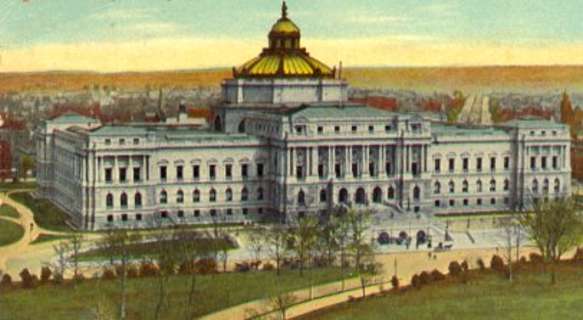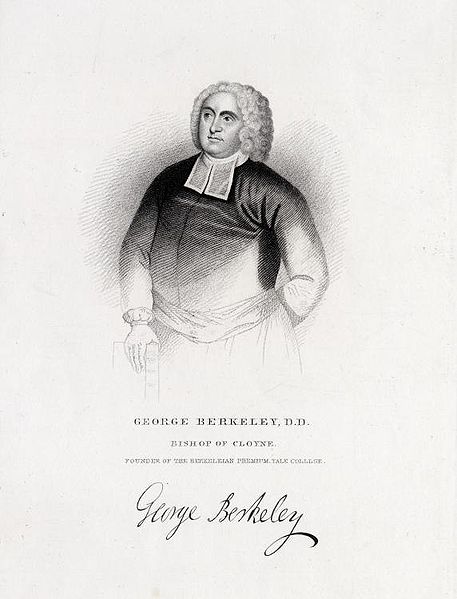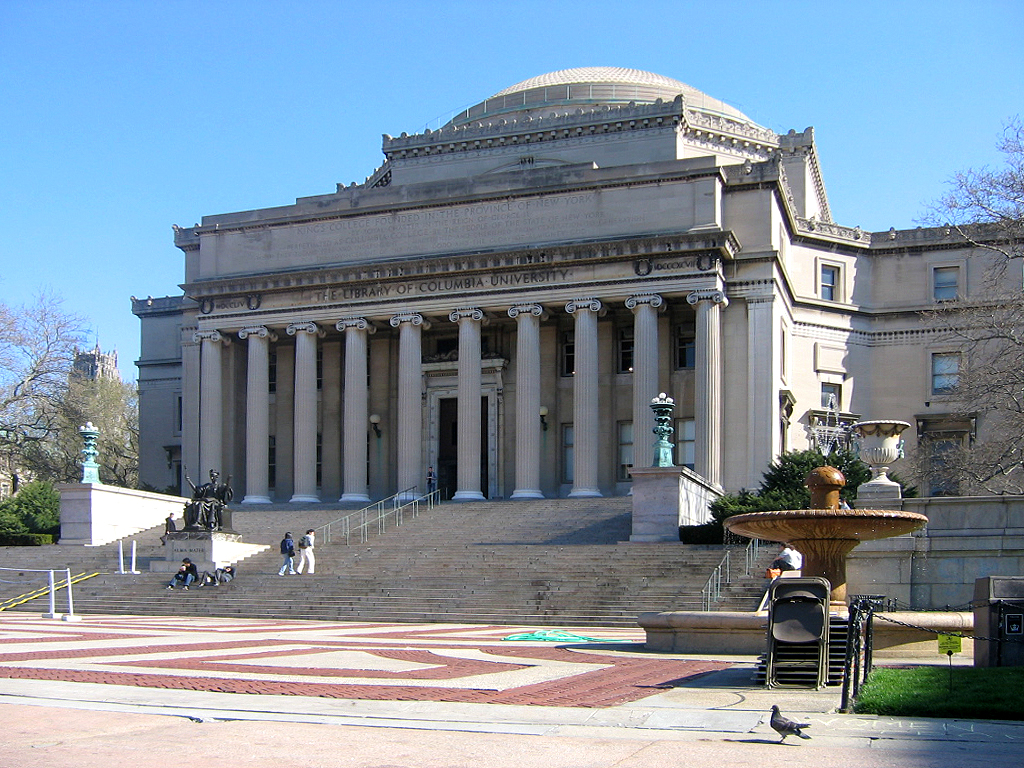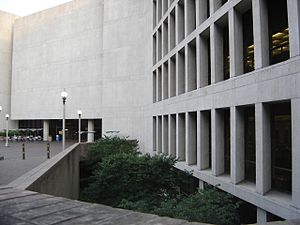A library "reading room," circa 1994, before the Internet.
Remember libraries? No? They're those places poor people go to rent movies* and homeless people go to "job hunt."** Imagine Google Books or Barnes and Noble, except these places have physical copies of books that you can read without having to buy them.
As a patron of some of our fair nation's greatest libraries (mostly for a place to crash for the night), I thought I would bring to you, fair reader, a report on these book-hoarding public and academic institutions. My source is the cleverly-titled "ALA Library Fact Sheet Number 22," put out by the secret union the "American Library Association," and last updated in 2008.
Unsurprisingly, the Library of Congress tops the list. Now two centuries old, our national library developed a book-spawning technique, not out of place in a 1950s science fiction novel, to expand their collections, growing from the nucleus of Thomas Jefferson's private library to its current 32.8 million volumes. Unfortunately, it remains true that only current members of Congress and lineal descendants of Jefferson can check out books from the Library of Congress.
Library of Congress (#1), c. 1910, designed, in part, by Jefferson's grandson, Washington Adams Madison (W. A. M.) Jefferson.
The two great libraries of the State of Massachusetts, the Boston Public Library and Harvard University Libraries, come in at nos. 2 and 3 on the list. Boston, which can claim the first newspaper in the western hemisphere, always has been a center of books and print culture. The BPL, established in 1848, has almost 24 million items in its collection, or four items for every person in Massachusetts (also the limit each person is allowed to check out at one time). The collections include over 3,000 books from the personal library of John Adams, although almost half of these are unsold copies of Adams' pamphlet Thoughts on Government.
The main branch of the Boston Public Library (#2), 1909.
The libraries of Harvard University, at no. 3, have over 16 million items in their collection. (Why does greater Boston get such a monopoly on books -- does their bibliophilic greed know no bounds?!?) The main library, the Widener, is famous for its dark and labyrinthine corridors of books, and the abnormal amount of ingenious murders that take place in its stacks. The Argentine author Jorge Luis Borges, after getting lost in Widener, famously remarked, "I have always imagined that Paradise will be some kind of library, but now I know the horrible depth of my error."
The Widener Library at Harvard (#3) extends over a mile underground in a complex series of basements, subbasements, nuclear-proof vaults, and catacombs.
The main branch of the New York Public Library (#4), c. 1920
Despite having more lion statues per capita than any other library system, the New York Public Library (which covers Manhattan, Staten Island, and the Bronx) comes in at only no. 4 on the list, with 15.3 million volumes. Little-known fact: Manhattan branches have no after-hours drop boxes for book returns because tramps and eccentrics use them as personal and refuse receptacles! The Greatest City in the World, they say!
The Sterling Memorial Library, Yale (#5). Take an audio guided tour of the library with Yalie and acclaimed fake professional historian David McCollough here!
As you might imagine, Yale University Libraries round out the Big 5. Sorry, Harvard -- with the help of Tommy Lee Jones you may have won the Greatest College Football Game Ever Played, but you lost the battle for Coolest Looking College Library. At 12.5 million volumes, Yale respectfully comes in second to Harvard, yet again! According to Wikipedia:
The amount of stone transported for the construction exceeded the amount used, and as a result, myths and legends abound on the Yale campus regarding fanciful structures claimed to exist on the roof, built of surplussed stone and metal. One story has a small castle hiding the air-conditioning system. Another claims that there exists an entire miniature city up there, complete with its own stone golf course.
Scholar John Hodgman, himself a Yale alum, claims that there is a miniature model of Sterling Library on the roof that has its own model on its roof, repeated infinitely. Surely several or all of these stories are true!
The Main Library at the University of Illinois, named after nineteenth-century university president Maynard Garrison Main. A former textile mill (note the industrial-sized chimneys), the building was donated to the fledgling university after an unfortunate fire on the top floor in which few of the seamstresses were able to escape the inferno. (Image courtesy of the U. of Illinois)
The first big surprise on the list is at no. 6, the libraries of the University of Illinois, with 11.6 million volumes. Hidden in the postindustrial twin-city sprawl of Urbana-Champaign (or "Chambana," as the locals call it), the flagship campus of the U of I boasts a huge collection, including the largest Slavic Language and Literature library in the United States! (Who knew there was more than one of these!?)
The original patron of the university libraries (L), and an aeriel view of the Doe Library at Berkeley (R).
(Image of library courtesy of the Univ. of California at Berkeley)
The libraries of the University of California at Berkeley fall in at no. 7, with around 11 million volumes. Widely considered to be the best public university in the U.S. (or, claim the Physics faculty, in the galaxy), the library at Berkeley (pronounced Bark-lee) received its initial endowment from noted philosopher George Berkeley (although it is now named after a wealthier, anonymous benefactor). Sadly, because of the state of California's budgetary woes, Berkeley, following the model of Brandeis University, has been forced to sell off much of their collection in giant monthly used book sales, with paperbacks going for two bits and hardbacks for a half dollar.
The Low Memorial Library at Columbia University. Okay, so it doesn't actually have any books anymore, but its much cooler-looking than the real library across La Plaza Mayor.
Nestled high in the Andes in the capital of Santa Fe de Bogota, the Columbia University Libraries have a collection of over 10.2 million items, and come in 8th on our list. To save on electricity, the cash-strapped institution formerly known as King's College has turned off the lights in most of the stacks, so the curious book-seeking patron (Columbia students and alums only, please) must furnish their own lantern or head lamp to navigate the shelves of books. Will someone please report this travesty to Robert "Cat Massacre" Darnton???
The Perry-Casteñeda Library at the University of Texas (#9): Fortress of knowledge or former Stasi headquarters? Only the architects know for sure.
At no. 9 are the libraries of the University of Texas at Austin, with 9.5 million volumes. As the worn out joke variation goes, library collections are bigger in Texas! Perhaps because it could be mistaken for a Stalinst housing project in East Berlin, the main library, the Perry-Casteñeda, it is by far the ugliest library on our list. Beware of the sixth floor, which is kept (for reasons unknown) at a constant temperature of 58 degrees. The campus legend is that there is a secret storage facility for the university's multi-million dollar wine collection, hidden somewhere inside the enormous "book cage" of books pulled from the stacks to be archived or burnt.
The Main Branch of the Public Library of Cincinnati and Hamilton County (#10), in downtown Cincinnati, Ohio. (Image courtesy of ncs.glc.com)
Rounding out our top 10 is another surprise, the Public Library of Cincinnati and Hamilton County (in Ohio), with 9.2 million volumes. Only the third public library on our list, the PLCH was founded in 1853 in the Queen City. It's really too bad that no one can find most of the branch libraries because of Cincinnati's notoriously confusing street plan and extremely mountainous terrain.
So, perhaps now, reader, you have a better understanding or our country's biggest collections of unread books and over-circulated Digital Video Disc movies. I encourage you visit all of them, perhaps on one giant road trip, where you start in Boston, wind your way by subway down to Washington, take a bus to Cincinnati, take a raft down the Mississippi south to Austin, then hitchhike to San Francisco. Or you could just visit them when you're already in town for a "high-powered business conference." Whatever floats your boat.
See you next time inside the Widener-Library-like recesses of the Cabinet, where curiosities rivaling those found on the roof of Sterling Library abound!
_____________________________________
* This was before the introduction of the popular Red Box movie rental device.
** Hobo code for "take a nap" or "give the slip to the bulls (railroad police)."
_____________________________________
* This was before the introduction of the popular Red Box movie rental device.
** Hobo code for "take a nap" or "give the slip to the bulls (railroad police)."













No comments:
Post a Comment